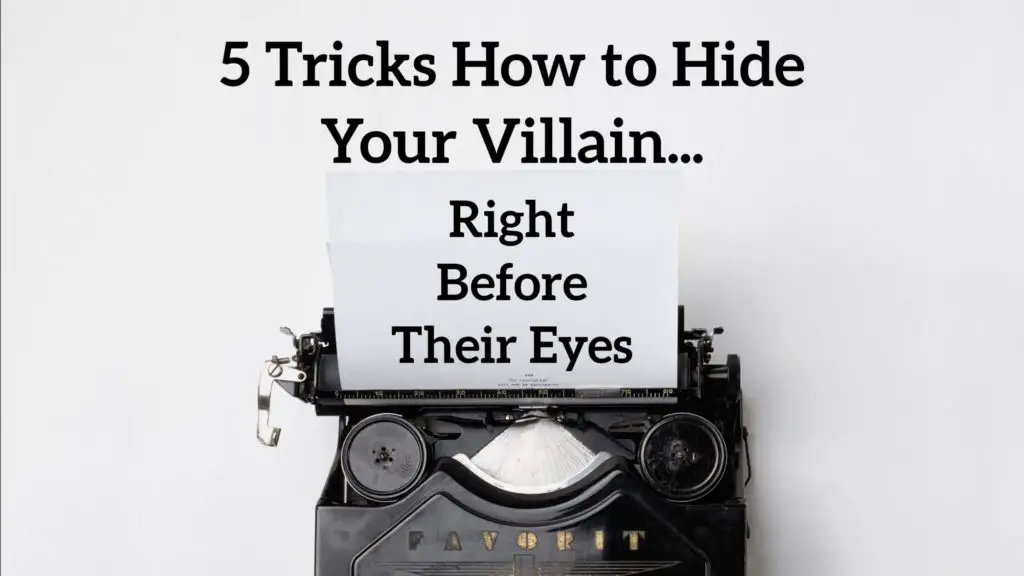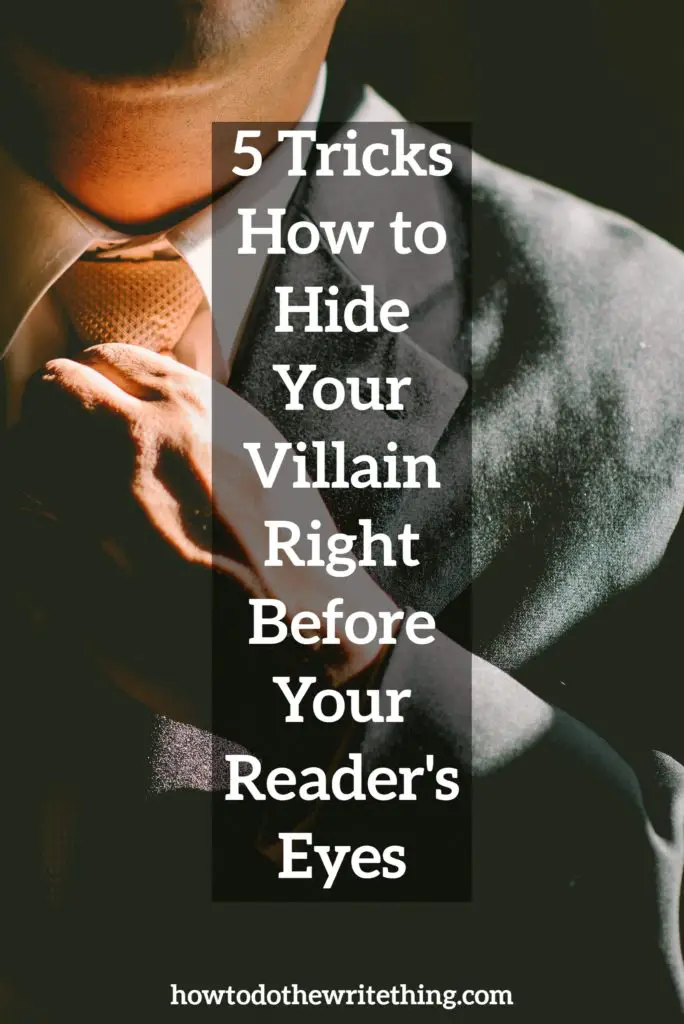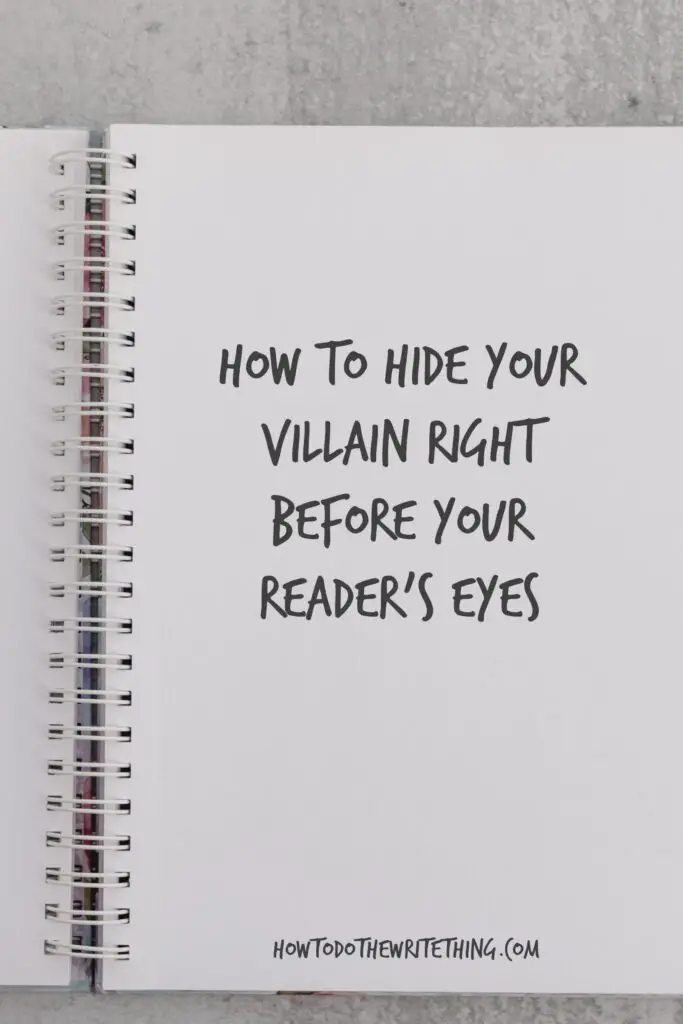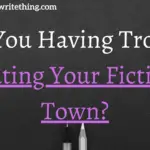
5 Tricks How to Hide Your Villain Right Before Their Eyes
One of the most fun and entertaining things to do as a story lover and writer is to hide the villain right in front of your audience and keep them guessing until the end.
Throw in a twist here and a twist there and voila, you surprise everyone that they knew who the villain was all along and they met them in chapter 2 but didn’t have a clue until the very end.
In some stories, the villain is bold and insidious and it’s obvious the entire time who they are, but some stories the villainous creature is scheming and conniving and even in their own mind is the good guy.
Whether your villain is insane and doesn’t recognize they’re evil deeds as evil or they are doing their best to fit into society and hide their dark secrets, it can be a lot of fun for readers to be surprised as to who the real villain is.
So here are some fun and creative ways that you can entertain your readers by hiding your villain right before their eyes:
1. Make your villain enjoyable.

When readers are poring over your words they expect to find the villain as some cruel ugly hag, but if you make her nice and kind and enjoyable, they might just skip right past this one on the possible guilty subjects list at first, expecting you to reveal them later, being none the wiser to have just met them.
Give your villain a scene or two where they are enjoyable and likable and perhaps even charming and potentially heroic and you’ll find folks are pleasantly surprised later on to learn that that charming character is actually an evil character in disguise.
Make your evil person a random shopkeeper that helps the protagonist find an item in the store in the first couple of chapters and even gives them a discount showing the villain to be charitable to throw them off the scent even more.
2. Make your villain an idiot.
A good way to hide your bad guy from your audience at first is to make them believe he is a fool or a bumbling idiot.
By making him a fool at first, you make them look like a side character in the story. That adds extra dynamics and enjoyment, but nobody would ever expect the fool to be the cunning evil undertaker in disguise.

3. Make your villain appear weaker physically.
Give them some sort of physical handicap to make them “appear” to be physically “weaker,” but in truth, they are NOT weaker at all. It is only a guise. Give them a limp or hobble. Make them a character with paraplegia or quadriplegia. Make your villain a character with muteness, deafness, or blindness so that your heroine and reader are none the wiser to their evil schemes and less likely to put them on their mental suspect list.
It doesn’t even have to be an actual ailment to your villain. The antagonist could be feigning the injury or birthed medical condition altogether. Both work equally well for making a dynamic character with complicated ideas and emotions.
Readers expect the evil antagonist to be strong and of equal strength physically to the protagonist. By making the villain appear “weaker” or “vulnerable,” your readers could look right over them and might not suspect a thing.
Think Mr. Glass in Unbreakable and Glass. People all around him underestimate him, but that is the most dangerous thing to do. The main antagonist in Glass assumed she could control and outsmart Mr. Glass and that was her fatal mistake.
Because of her foolish assumption, she fell right into his plans perfectly and handed him everything he needed to show the world that the myth of superhumans was real. She assumed she was smarter than him and could control him and that was her downfall.
(Side note: make sure to have the utmost care and respect with how you research disabilities and write characters with disabilities, whether they are humans or fantasy creatures that you are writing. We all have friends and loved ones we know with disabilities, so be kind and respectful. Disabilities can be written about in fiction in a responsible and respectful way 🙂 .)
Want to get paid to write? Check out Writing Paychecks
- There is a simple method over 30,000 people use to get paid for freelance writing online.
- Opportunities can get started in just minutes a day, all from your home couch.
- It’s easy to get started! No previous experience or degree required to start.
- Exclusive job listings for writers, updated daily.
Check out Writing Paychecks to see if you can start getting paid to write today.

Interested in starting a blog of your own? Check out Bluehost.
After checking out Bluehost, see how we made a profit FAST with our blog and how you can too: Our #1 Easy way that we made a profit with our blog on year 1, not year 5.
Need a Cheaper Plan? Try DreamHost.
Try Grammarly, The Free tool that should be in every writer’s toolbelt.
4. Make them attractive.


One of the easiest ways to throw your readers off the scent of the villain is to make them attractive. Make them kind, polite, and charming.
Make them the life of the party. The person that could spit in your face and that you would still want to be their friend and have their attention.
That character could never be the villain, could they?
5. Make the villain assist the protagonist.
Have the protagonist meet them on a train ride and have the villain help them find their cart and sit with them and have a very needed helpful conversation.
You could go as bold as to have the villain be there “sidekick” up until the time of turning against them, or you could have the villain help them in a moment and turn the reader’s mind to think that the villain is just a kind helpful person in the story.
Take this as far as you like.
I hope this helps! Now get out of here and write something!
Interested in starting a blog of your own? Check out Bluehost.
After checking out Bluehost, see how we made a profit FAST with our blog and how you can too: Our #1 Easy way that we made a profit with our blog on year 1, not year 5.
Need a Cheaper Plan? Try DreamHost.
Try Grammarly, The Free tool that should be in every writer’s toolbelt.
Make sure your posts are readable. Use this readability score check.
Bonus Material for fans of “How to Hide Your Villain In Plain Sight”
How to write A Game Making Villain
It’s the last quarter. There are only 30 seconds left in the game.
The rivalry is heated and both sides want the WIN but only one can have it.
The good guy knows he is good but he knows that the villain is just as strong as him and maybe even smarter than him.
The stakes are high. At the end of this 30 seconds, the power of the universe will be either in the hands of good or the hands of evil.
What will happen and what will decide the fate of the universe?
So how do we do this as writers day in and day out?
How do we write a villain that is a game-changer or game maker?
The villain is equally important if our reader is to feel any emotion from our telling of the story.
So how do we make sure that our villain does his job in pushing back the heroine?
How to Write A Game Making Villain:
- Write a Villain that Draws us in and surprises us
- Write a Villain that could be your reader’s next-door neighbor
- Write a Villain that doesn’t care about anyone but themselves
- Write a villain that has extenuating qualities
- Write a villain that has a palpable description
Write a Villain that Draws us in and surprises us
One of the key secrets to great storytelling and writing stories is creating surprise.
Most writers and critics would call this a twist at times, but it doesn’t always have to be a twist.
With a villain that surprises our reader, it could be an act of cruelty.
One great way to do it is betrayal.
Think Judas and Jesus. Think Brutus and Caesar, “And you Brutus…”
Betrayal is a great way to surprise our reader with who the villain is as well as really put on the emotional sting when they find out.
The Way to Set Up Betrayal
If you want to use betrayal to surprise your reader with your villain you’ll have to set it up for it to have a great effect.
The villainess should start out in the story as someone close to the heroine. It could be their sister, mother, cousin, or best friend.
When we meet the villain we should think that they are a side character and are good.
Write them playing with the heroine as children. They can grow up together telling each other their deepest most trusted secrets.
They can go to the same school, or live in the same castle.
They can fight alongside one another in battle or be on the same basketball team.
Whatever you choose, make them close before ultimately showing that the villain was right underneath the reader’s nose all along and then write them doing some act of betrayal and showing little remorse for it.
They could be cheating with the heroine’s boyfriend or husband.
They could be secretly plotting to kill them to take their place on the throne.
They could be planning to take revenge for an act the heroine didn’t know they felt bitter about.
Whatever you choose, make the betrayal heinous and hard for the reader to accept without feeling angry for the heroine, or it might not work in the story.
Write a Villain that Could be Your Reader’s Next-Door Neighbor




If you want your villain to be bigger than life, you need to make sure the villain comes across as a plausibly real person.
Villains that are fun but too spooky are sometimes forgettable, but the villain that could be their next-door neighbor in real life is hard to get out of mind. If they have a hard time looking at their neighbors the same way after they have read your story then you’ve opened up their eyes to how dangerous a seemingly “good” person can be.
The idea is the psychopath next door.
Write the villainous character as someone that is the leader of the neighborhood watch in the cul de sac.
Everyone knows and loves the villain and the villain is greatly kind and generous in daylight and during office hours, but if you somehow got surveillance into their private home or office you’d cringe to find out what they are doing in secret.
That’s the key to a game making villain that’s real, but pure evil.
They are kind and generous in public, but in secret, they have nasty skeletons in their closet, or better yet the backyard of their second home.
Don’t take this overboard, don’t write them as fake nice that’s so easy to see through. Write them as genuinely kind so that when our reader learns what they do when no one is looking, they’ll be shocked, surprised, and in horror.
You can even carry this out in a creative way by picking a person in real life that you know or look up to.
Give the villain their personality and mannerisms and this will help your reader see and believe that this character is very real to life and could be their next-door neighbor.
Write a Villain That Doesn’t Care About Anyone But Themselves
A game making villain is completely selfish. A complete narcissist could work.
But don’t be so extreme or your reader will just be sick of them and ready to see them die or lose and move on.
Their actions have to give the reader hope that there is some good in them.
One of the reasons Darth Vader was so HUGE in villain history is that the entire trilogy Luke was saying “I can see the good in you. There is still hope.”
If our readers see a villain that does good things but surprises them with the evil deeds the villain commits our readers might cling to the idea that it is possible that they could change.
Leaving it possible means that curiosity about the villainess character can continue.
But we as the writer know deep down inside that our villain is complete and utterly consumed with selfishness and will never change despite leading the fact that the villain manipulates our heroine and leads them on.
Write a Villain that Has Extenuating Qualities
Give the villain excuses for the way he or she acts.
Give them a goal that the reader could possibly perceive as a good goal.
In Lord of the Rings, every member of the Fellowship of the Ring had the potential for good and evil.
Boromir wanted to take the ring and use it as a “weapon against the enemy.” But everyone knew the ring poisoned the wearer’s mind, turning them insane or against the good and towards the evil Saruman, making anyone a potential threat.
When Boromir says they should use it against the enemy it is tempting to think that this is a good idea. But deep down we as the readers know this is a bad idea.
When Boromir acts in this way his motives are potentially good, so when he tries to take the ring from Frodo the reader can be curious to know if his actions are good or bad. During this act, he acts as a potential villain but in the end, we know that ultimately the true villain is Saruman.
When we do this for the reader we make the villain and their acts more emotional and deep for the reader.
Write a Villain that has a Palpable Description.
Use the physical description of your villain to make her or him jump off the page and into your reader’s mind.
Give your villain a back story that leaves them with a hideous scar.
Use that scar to tell a story.
For example: the character has a deep gash in their back. When the villain was six years old the hero was fighting another villain in the same neighborhood that they lived in. The fight got so bad that it ended up destroying a part of the building above the villain. The villain’s apartment caved in and it killed her parents. A piece of rubble pierced her back and totally severed her spine, leaving her a paraplegic for the rest of her life. The villain blames the hero for her parents’ consequent deaths and her paraplegia. She hates the hero for this and plots ways to get revenge every single day.
Try to think of other ways to use their physical description as a way to remind the reader of their twisted back story.




Interested in starting a blog of your own? Check out Bluehost.
After checking out Bluehost, see how we made a profit FAST with our blog and how you can too: Our #1 Easy way that we made a profit with our blog on year 1, not year 5.
Need a Cheaper Plan? Try DreamHost.
Try Grammarly, The Free tool that should be in every writer’s toolbelt.
I hope this helps you write a game making villain!
Now get out there and write something!
Other posts you might just love to munch into:
How To Write 4 Scenes That Reveal Who Your Character Is Seamlessly
4 Tips How to Write your Character Hitting Rock Bottom
5 Tricks How to Hide Your Villain Right Before Their Eyes






